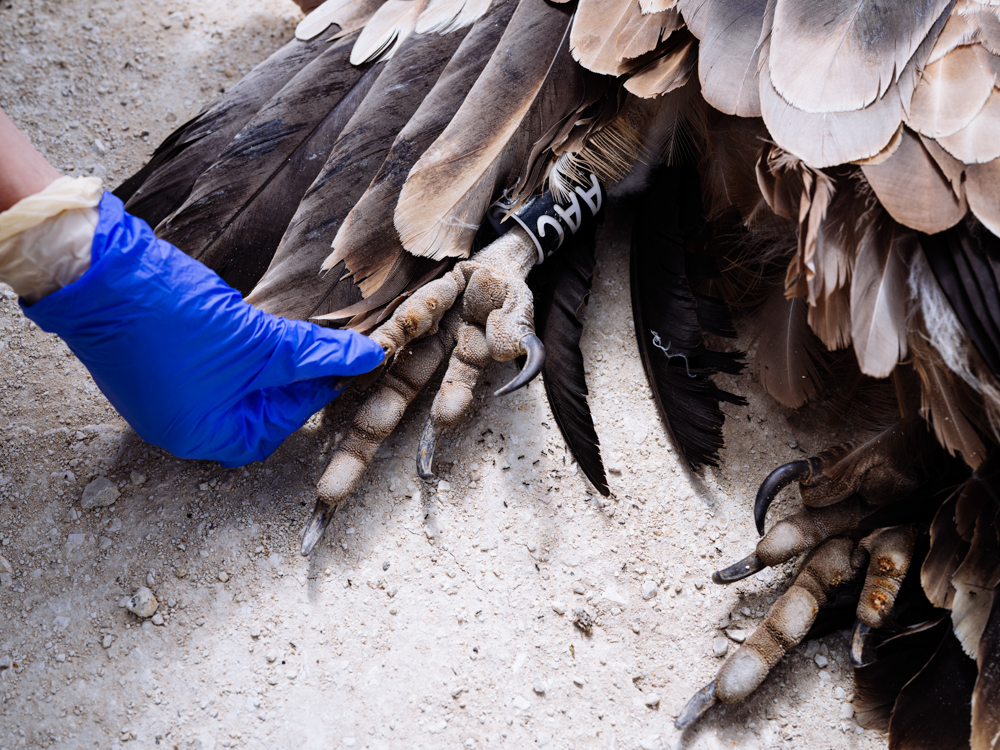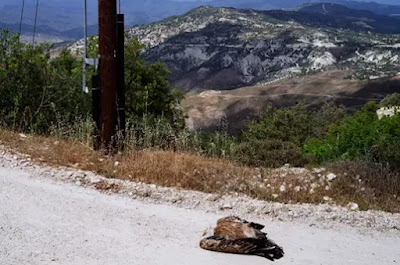Filenews 10 May 2024
Two more vultures fell victim to deadly EAC piles in recent days, despite the appeals and warnings of experts.
According to a joint announcement by partners implementing the "LIFE with vultures" project, last Saturday, two fulvus vultures died from electrocution on piles of EAC's Medium Voltage overhead network that supply a CYTA antenna, in the area between Kelokedara and Salami. In April 2022, at the exact same spot, another vulture died from electrocution, while in the same area in 2018 a vulture died after colliding with an overhead line.
These piles, located in the core of Griffon Vulture territory, are a death trap for this highly endangered and protected species, while the two recent deaths amount to enormous ecological damage. The underground cables, the use of insulated cables, the insulation of piles or the use of safe type of piles that prevent the electric shock of birds are simple measures taken in many European and other countries and allow the coexistence of the power grid with wildlife.
At the same time, they express their disappointment that these deaths could have been avoided "if EAC had implemented corrective measures at this location when it was informed about the danger of these piles following the death of the first vulture in 2022". Although EAC has shown willingness to insulate the piles and although for 4 years there has been a relevant budget available to EAC from the Game and Fauna Service through a European program, lack of measures led to the death of two more vultures by electric shock.
"Since vultures often pass through this area, it is only a matter of time before further losses due to electric shock occur on these piles, which vultures often use for rest. The two deaths represent a significant loss for the very small Griffon Vulture population, which now numbers 27 birds, while significant European and national resources are being spent on the recovery of the species."
According to the announcement, both impacts and electric shocks on the electricity transmission network burden the conservation status of both the Griffon Vulture and the Spiny Eagle Aquila fasciata – species with strict protection status by national and European legislation. "Data from satellite transmitters carried by the Griffon Vultures and Bonelli's Eagles of Cyprus show that collision with overhead power lines and electric shock are the second cause of Griffon Vulture mortality and the third cause of Bonelli's eagle. Within two years, five vultures have died due to electricity infrastructure and since 2018 nine eagles have been lost due to impact and/or electric shock. Of course, these numbers are most likely an underestimation of actual mortality levels from these causes, as not all birds carry satellite transmitters and dead birds are not always detected. In addition, several other bird species have been found dead from impact or electric shock such as Cranes, Peregrins, Eleanor's Falcons, Buzzards and smaller species."
Well-designed electricity transmission and distribution networks play a key role, say the LIFE with vulture partners, in the conservation of bird species and Natura 2000 protected areas with the aim of protecting bird species, prevention of mortality and avoidance of fires from electric shock incidents. "The mitigation of impacts on Natura 2000 areas and protected species by EAC infrastructure is EAC's responsibility, based on the provisions of the Protection and Management of Wild Birds and Game Laws of 2003 to 2020. Therefore, the design of piles and the passage of Medium and High Voltage lines from specific areas should take into account the above".

At the same time, reference is made to two European programs ("LIFE with Vultures CY" and "LIFE Bonelli eastMed"), in the context of which, the Game and Fauna Service and BirdLife Cyprus, as implementing bodies of these programs, have secured significant funds of 150 thousand euros from national, private and European resources that facilitate the implementation of mitigation measures by EAC to reduce mortality in important bird species. such as marking overhead high-voltage lines to avoid collisions and insulating pillars and piles to avoid electric shock. However, not only have these measures not yet been fully implemented but, on the contrary, there is a long delay in their implementation.
They call on those responsible to address the situation. "The EAC, at the suggestion of the Game and Fauna Service, should act immediately for the insulation of all piles that have been identified as high risk for electric shock for the Eagle and the Griffon Vulture, as well as the marking of high-voltage overhead lines with a high risk of impact for the Griffon Vulture|".

"The Game and Fauna Service, BirdLife Cyprus and Terra Cypria, as they have already stressed in their previous announcement in 2022, consider it imperative that these discussions with EAC take place before we need to collect more dead birds from the countryside. This delay now undermines the intensive and costly efforts made in recent years to conserve the Griffon Vulture and the Bonelli's Eagle in Cyprus."
Finally, they call on EAC to implement the appropriate policy that will justify it as "Golden Protector of the Environment" during its recent award as such.
